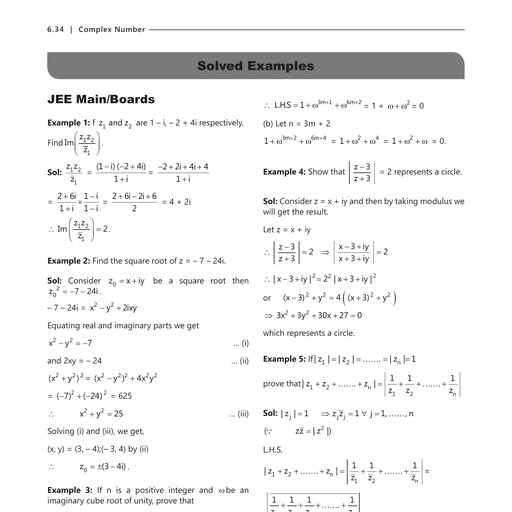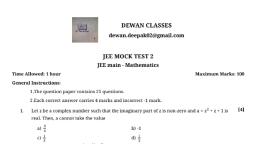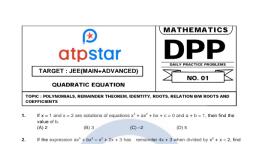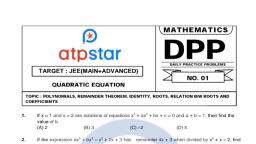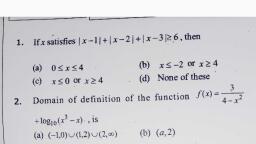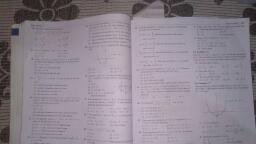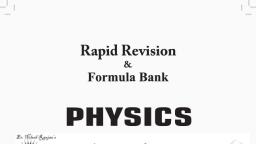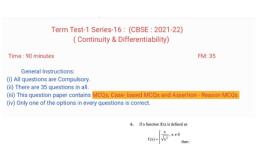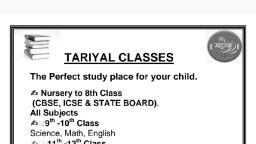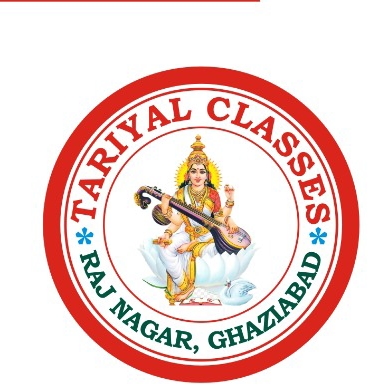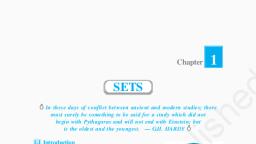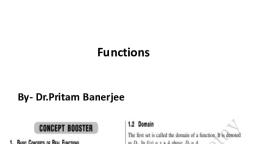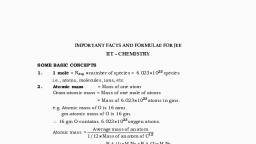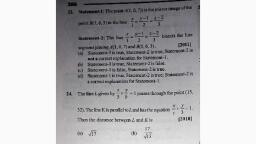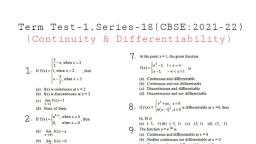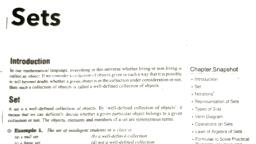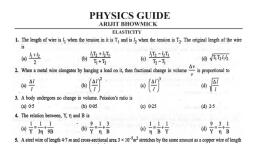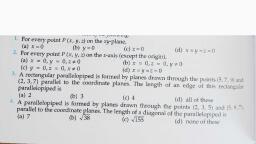Page 1 :
REVISION CAPSULE - MATHEMATICS, , , , © Arelation R froma set A toa set Bis, a subset of the cartesian product A x B, obtained by describing a relationship, between the first element x and the second, element y of the ordered pairs in A x B., © Function: A function f froma set A to, a set B is a specific type of relation for, which every element x of set A has one, and only one image y in set B. We write, f: AB, where f(x)=y., , A function f: X > Y is one-one (or injective) if, , £&) =f) >x, =x, V Xx, EX., , A function f: X — Y is onto (or surjective) if given any, , y © Y,4 x € X such that f(x) =y., , Many-One Function :, , A function f : A> B is called many- one, if two or more, different elements of A have the same f- image in B., , Into function :, , A function f: A> Bis intoif there exist at least one element, in B which is not the f- image of any element in A., , Many One -Onto function :, , A function f: A= R is said to be many one- onto if fis onto, but not one-one., , Many One-Into function :, , A function is said to be many one-into ifit is neither one-one, nor onto., , A function f: X — Y is invertible ifand only if fis one-one, and onto., , RELATIONS, AND, , FUNCTIONS, , , , o 89 8 8 898 98, , © General Solution of the equation, sin® = 0:, when sin@ =0, O=n7:nelie.n=0,+ 1,42..., General solution of the equation, cos8 =0:, when cos@ = 0, 0=(2n+ Iw2,n€Lien=0,+1,+42......., General solution of the equation tan0 = 0:, General solution of tan0 = 0 is 0=nz;n eT, , © General solution of the equation, (a) sind=sina: 0=nzt+(-l)"a:nel, (b) sind =k, where -1<k <1., , 0=nn+(-1)"a, where n € land a=sin'k, (c) cos =cosa: 0=2nn+a,n eI, @ cos@ =k, where-1<k<1., 0=2nn+oa, where n € landa=cos'k, , (e) tanO=tana: 0=nt+a;nel, (@ tan0=k, 0=n7+ a, wheren € landa=tan'k, (g) sin?@ =sin?a : 0 =nt+a;n el, (h) cos?0=cos’a: O=nt+a:nel, (i) tan’@=tan’a : O=nnta;nel, , TRIGONOMETRIC FUNCTIONS, , , , AND, EQUATIONS, , , , , , , , e900 88 8 8 @, , , , tonterms, , , , sina. + sin (a+ B) + sin (a +26) +., , sin [=+(*5*}5]|»(*)], 2 2, = —sin@/2)—SOCS~S 3 B¥2n7, cosa. + cos (a. + B) + cos (a +28) +........ ton terms, n-l . (np, 7 cos [=+(22) 6| [sm (*), , ;B # 2nn, , , , , , , , , , , , nel sal, San sin 2 . sin 2 . sin 2, , a=ccosB+bcosC, , , , Maximum value ofasin0+bcos0 = Va? +5? andminimum, , value ofa sin 0 +b cos 0 =—Va? +b?, , © Properties of inverse trigonometric, function, , , , INVERSE stax +tanty, TRIGONOVETRIC, FUNCTIONS wn-*(242), ifxy<l, =| netant(Xt¥) ifx>0y>o, I-xy and xy>1, if 0, 0, agent oe: . ifx<0,y<, =xy}? and xy>1, , etan! x—tanly, , [es . ifxy>-l, 1+xy, , = retan{ 2-2), , l+xy, , te), -n-+tan, I+xy, , , , if x >0,y<Oand xy <-l, , , , , , . ifx <0,y>Oand xy<-I
Page 2 :
REVISION CAPSULE - MATHEMATICS, , , , esin'x+sinty, sin{xy-y? + yvi—x),, =) a-sin xsi? + vi?), -a-sin""{xyi-y? + yi},, , *cos!x+costy, , - a =, , 2n-cos {xy-V1-x? y1-y7},, , if-1<x, y<l and x?+y? <1, or if xy<O and x?+y?>1, , if 0<x, ysl, and x? +y?>1, , , , if -1<x, y<0 and x?+y?>1, , >» if-1¢x,ySlandx+y20, if-1Sx,ySland x+y $0, , sintxvi-w) , if-Lexst, , , , , , , , , , yee 2, 2sin'x= }-sin- laxy1-x? ) if 5sxsl, 1, —n-sin !(2x 1-x? ). eek, v2, tar( 2) , if-l<x<l, Le, 2tan!x= tan [ x). ifx>1, T=, na ox ) if x<-l, I=x', , © Roots of a Quadratic Equation : The, roots of the quadratic equation are given by, , orb vb? - dae, 7 2a, , Nature of roots : In Quadratic equation, ax? + bx +c =0. The term b? —4ac is called, discriminant of the equation. It is denoted by A or D., (A) Suppose a, b,c € Randa¥0, @ IfD>0 => Roots are Real and unequal, di) IfD=0 = Roots are Real and equal and each equal to, —b/2a, Roots are imaginary and unequal or, complex conjugate., (B) Suppose a, b,c € Qanda#0, (i) IfD > 0 and D is perfect square = Roots are unequal and, , Rational, , (ii) IfD > 0 and D is not perfect square => Roots are irrational, and unequal., , QUADRATIC, EQUATIONS, , AND, INEQUALITIES, , , , qi) ITD<0 >, , Condition for Common Root(s), Let ax? + bx + c= Oand dx? + ex + f= 0 havea common root, (say)., , i _ a bic, Condition for both the roots to be common is ae f, , Ifp + iq (p and q being real) is a root of the quadratic equation,, where i =/—1, then p ~iq is also a root of the quadratic, , equation., Every equation of n" degree (n > 1) has exactly n roots and, if the equation has more than n roots, it is an identity., , eo 8 8, , °e, , , , , , © Exponential Form: Ifz =x + iyisa, complex number then its exponential form, is z = re where r is modulus and 0 is, amplitude of complex number., , O@ |Z | +] 2 |2| 2, +2 | shere equality, holds when arg(z,/z,) = Oi.e. z, and z, are, parallel., , Gi) || Zz, |—| 22 I$] 2-2 | : here equality holds when, arg(z,/z,) = i.e. z, and z, are parallel., , (iii) |2,+2,P+|z,-z,P=2(|z, 2 +12 |?), , arg(Z\Z7) = 0) +9) = arg(z)) +arg(Z2), , ae 2) 2, Aa,, For any integer k, i= 1, i***! =i, i#**?=—1, i***3, |z—z,|+|z—Zy |=, represents an ellipse if, |z,-z,|<A, having the points z, and z, as its foci. And if, |Z —Z) |=, then z lies on a line segment connecting z,, , andz,., Properties of Cube Roots of Unity, , (i o=1, , COMPLEX, , NUMBERS, , 0, = arg(z,)—arg(Z2), , , , (i) l+o +o? =0, , Gi) 1+4@"+@7" =3 (ifn ismultiple of3), , (iv) 1+" +@2"=0 (ifnis not a multiple of 3)., , The number of permutations of n, different things, taken r at a time, where, repetition is allowed, isn’., , (© Selection of Objects with Repetition :, , The total number of selections of r, things from n different things when each, thing may be repeated any number of times, is™"C,, , Selection from distinct objects :, , The number of ways (or combinations) of n different things, selecting at least one of them is"C, +"C,+"C, + .....+°C,, , =2"—1. This can also be stated as the total number of combination of n different things., , Selection from identical objects :, , The number of ways to select some or all out, of(p+q+r) things where p are alike of first kind, q are alike, of second kind and rare alike of third kind is, , (pt qt (rt1)-1, , Selection when both identical and distinct objects are, present:, , Tfout of (p+ q+1r+t) things, p are alike one kind, q are alike, of second kind, r are alike of third kind and t are different,, then the total number of combinations is, , (p+ Dt Det D2, Circular permutations:, , (a) Arrangements round a circular table :, , The number of circular permutations of n different things, , a, , PERMUTATIONS AND, , COMBINATIONS, , , , taken all at a time is ts =(n — 1) !, if clockwise and, , anticlockwise orders are taken as different.
Page 3 :
REVISION CAPSULE - MATHEMATICS, , , , (b) Arrangements of beads or flowers (all different) around, acircular necklace or garland:, The number of circular permutations of ‘n’ different things, , tarsal ‘ 4 % ., taken all ata time is za- 1)!, ifclockwise and anticlockwise, , orders are taken to be some., , © Sum of numbers:, (a) For given n different digits a,, a,, a, ......a,, the sum of the, digits in the unit place of all numbers formed (if numbers are, not repeated) is (a, +a,+a,+ a,)(n-1)!, (b) Sum of the total numbers which can be formed with given, n different digits a,, a,, .........a, iS, (a, +a, +a; + +a,)(n—1)!.(111.......1 ntimes), , , , , , © Greatest binomial coefficients : Ina, binomial expansion binomial coefficients of, BINOMIAL \ the middle terms are called as greatest, THEOREM _} binomial coefficients., , , , n, (a) Ifn is even : When r ay ie. "C,, takes, , maximum value., n-l n+l, ) Ifn is odd: r =—>— or >, a _a,, ie. cea - Sat and take maximum value., , © Important Expansions:, If|x|<1andn € Qbutn ¢N, then, , , , -1, (a) (+ x)=1+nx+ a 2, é n(n—1). i,, , , , (b) (1—x)?= 1-nx+ mae b x= afar Dar2) we 2) x, , 4 n(n—1)....(n—r+1) otto, rl, , © Properties related to A.P., , (i) Common difference of AP is given by, , SEQUENCE d=S, — 2S, where S, is sum of first, , AND SERIES two terms and S, is sum of first term., , (ii) Iffor an AP sum ofp terms is q, sum of, qterms isp, then sum of (p + q) term is, (p+q)., , (iii) In an AP. the sum of terms equidistant from the beginning, and end is constant and equal to sum of first and last terms., , (iv) Ifterms a), a,,..., A, A,.4.---525,, are in A.P,, then sum of, , Lele, , these terms will be equal to (2n + 1)a,, , , , Ins", (vy) Iffor an A.P. sum of p terms is equal to sum of q terms, then sum of (p + q) terms is zero, , (vi) Sum of n AM's inserted between a and b is equal ton, , n, times the single AM between a and b i.e. yA =nA, , rel, , a+b, whereA=——, , The geometric mean (G.M.) of any two positive numbers a, and bis given by Jab i.e., the sequence a, G, b is GP., , n GM's between two given numbers: If in between two, numbers 'a' and'b’, we have to insert n GM G,,G,,..........G,, then a,, G,,G..........G,, bwill be in GP., , The series consist of (n +2) terms and the last term is b and, first term is a., , , , , , 1, , bya, => art2t=p =r-(2 a, , a, , G, =ar, G,= G,= ar" or G,= bir, Use of inequalities in progression :, , (a) Arithmetic Mean > Geometric Mean, (b) Geometric Mean > Harmonic Mean :, , A2G2H, , , , © Anacute angle (say 0) between lines, L, and L, with slopes m, and m, is given by, mp “mp, 1+mm,, , tan® = , 1+mm, #0, , , , , , © Three points A, Band C are collinear,, ifand only if slope of AB = slope of BC., The equation of the line having normal distance from origin, is p and angle between normal and the positive x-axis is @, is, given by x cos@+ysinw=p., Co-ordinate of some particular points :, Let A(x,,y,), B(x,,y,) and C(x,,y;) are vertices of any, triangle ABC, then, Incentre : Co-ordinates of incentre, , hc witb +e), a+b+c ° atb+e, , where a, b, c are the sides of triangle ABC, Area ofa triangle : Let (x,, y,), (x, y,) and (x, y5), respectively be the coordinates of the vertices A, B, C of a, triangle ABC. Then the area of triangle ABC, is, , 1, 2 IX, )- Yt W3-Y) +X; 2), Or
Page 4 :
REVISION CAPSULE - MATHEMATICS, , , , Condition of Tangency : Circle, x? + y? =a? will touch the line., , y=mx+cife=+ avl+m?, , © Pair of Tangents : From a given point, P( x,,y,) two tangents PQ and PR can be, drawn to the circle S=x?+ y?+2gx + 2fy+, c=0. Their combined equation is SS, = Hea, Condition of Orthogonality : Ifthe angle of intersection of, the two circle is a right angle (6 = 90°) then such circle are, called Orthogonal circle and conditions for their orthogonality, is 2g,8, + 2f,f, =c, tc,, Tangent to the parabola :, Condition of Tangency : If the line y= mx + c touches a, parabola y? = 4ax then c=a/m, Tangent to the Ellipse:, Condition of tangency and point of contact :, The condition for the line y = mx + c to be a tangent to the, , 5B, , , , ellipse Pt yee is that c= a’m?+ band the coordinates, am _ wv), , omg, , Va?m? +b? Ya’m? +b? ], , (, of the points of contact are \F, , Normal to the ellipse, (i) Point Form : The equation of the normal to the ellipse, , , , 2 ot, 2+ =1atthe joint (x,, y,) is —— >, 2 we Pi v V1 XY, , (ii) Parametric Form : The equation of the normal to the, , ae), , ellipse ata = | at the point (a cos0, b sin®) is, a, , ax secO — by cosecO = a? —b?, , Tangent tothe hyperbola :, , Condition for tangency and points of contact : The condition, , for the line y = mx + ¢ to be a tangent to the hyperbola, , i fi, x, > oa = 1 is that c? = a’m?—b’ and the coordinates of the, , cs, , am b?, , , , (, points of contact are (, , tm vi), Va?m? —b mt), Chord of contact :, The equation of chord of contact of tangent drawn from a, , a., x, , point P(x,,y,) tothe hyperbola a =lisT=0, a, , whereT = “13% _j, , 2 2, a b, , Equation of normal in different forms :, , Point Form : The equation of the normal to the hyperbola, , xy gtk eY ay, , 2 = Lat the point (x,, y,) is x ¥i =a’+b', , , , Slope Form : The equation of normal to, 2 2, , x, THREE the hyperbola > — aE = 1 in terms ofslope, a, , DIMENSIONAL, , ‘mis, , GEOMETRY, , m(a? +b?), , , , , , , y=mx+, , © Conditions of Parallelism and Perpendicularity of Two, , Lines:, Case-I : When dc's of two lines AB and CD, say /,,m,, n,, and ¢, ,m,,n, are known., , AB||CD ¢,=/,,m,=m,,n,=n,, , AB LCD © ¢,¢,+m,m,+n,n,=0, Case-II : When dr's of two lines AB and CD, saya,, b, c, and, a,, b,, c, are known, , a _ by, ABIICDS 35, 7 oy, , AB LCD = aja, +b,b, + ¢,c,=0, , © If¢,,m,,n, and ¢,, m,, n, are the direction cosines of two, , lines; and 0 is the acute angle between the two lines; then, cos 0=| ¢,/,+m,m, + n,n]., , © Equation of a line through a point (x,, y,, z,) and having, , , , X7Xy_ VV _ 27-4, ie m, , direction cosines /, m, nis, , B, , © Shortest distance between 7 = 4, +b, and F=4, +pb,, , , , (by xb9).Gy — y, , is, , , , [by xb3 |, , © Let the two lines be, , , , , , , , mien (1), X—0) _ y—By _ 2-12, and % m, ny sxescen(Q)., These lines will coplanar if, O)-O% Br-Br Y2-%1, & my MN | =0, ly my ny, , The plane containing the two lines is, , x-a y-By 2-14, & m, m |=, f Mm ny, , © __ The equation of a plane through a point whose position, , vector is 4 and perpendicular to the vector \) is, , (f-a).N=0

